Photography aggregator blogs – sites dedicated to curating themed, oft-uncredited photography – have breathed novel aesthetic appeal into the concept of “liminal space”: places haunted not by death but by the hazy feeling of a 2 A.M. layover, the mystique of being neither here nor there. It’s a comfortable sort of haunting. These spaces are precisely as conditioned as they need be for you to cross them. Though the hotel hallway may be anxiety-inducing in length and repetition, you don’t expect to die here, because you don’t live here. No one does.
Guerrilla Cenotaphs: Dignifying Life, Death, and Memory
While governments dehumanize the dead at the U.S.–Mexico border city of Mexicali, a community of mourners work to assert their loved ones’ humanity.
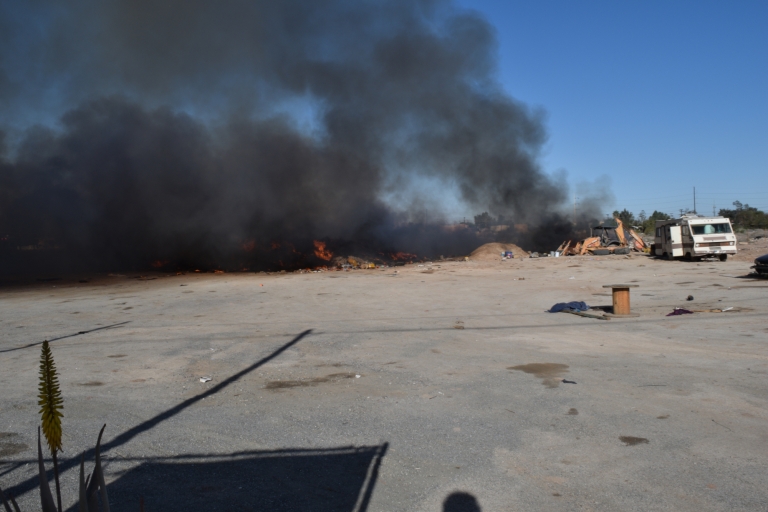
As braving the desert unshielded is pernicious, so is Mexicali, Mexico almost liminal. There are few parks, but many roads. Some of this is the semi-accidental result of sloppy central planning. Some, the careless cruelty of capital hoarding–dusty, trashed vacant lots waiting to be sold for a profit. Another structure is the intentional imposition of liminality onto a place where people live. Mexicali ends at the American border wall, a behemoth of steel and barbed wire, an invitation rejected: here is a crossing, but you’d best not even try.

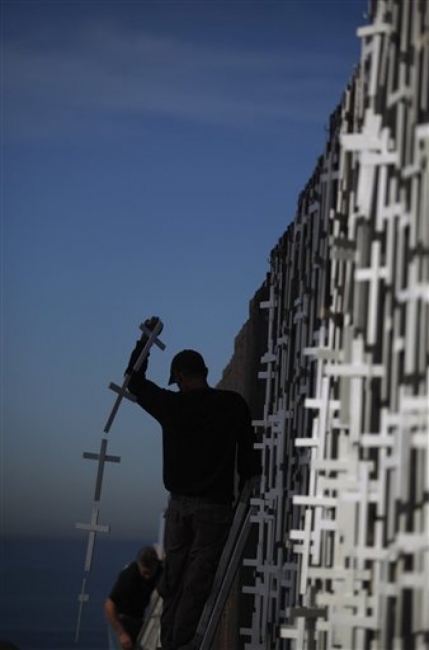
This border wall is lethal by design. On one side, one risks death by falling from its twelve-ish meter drop, while on the other side, a massive, foreboding gash of desert which comes with the tacit understanding that exposure will deal with those that avoid capture. Securing the body of a loved one that died crossing the border is a transactional nightmare, if not a honeypot: with Border Patrol itself taking missing person reports, undocumented immigrants reporting their missing loved ones face potential deportation. Corpses and the individuals behind them are reduced to statistics. More than liminal, the border is arid: it rejects life to the point of resenting death. Death is the admission that life once took root here, that “KEEP OUT” signs and the Border Patrol are not impermeable.
The USA is not the only arid side of the border. The influx of South American immigrants to Mexicali elicited an opposing wave of protests against the creation of refugee shelters. Deserts spread as we replicate America’s rejection onto our own immigrants.
There is an old Spanish joke about being so broke that you cannot afford to drop dead, that still rings true. Mexicali’s largest funeral firm offers, at cheapest, cremation funerals at around 14 thousand pesos, or three months’ worth of labor in the maquiladoras that make up the bulk of Mexicali’s economy. This basic service does not include niche maintenance, and immigrants are often homeless.
America’s statistics dehumanize the dead, while Mexico plays accomplice by not accounting for immigrant deaths on our side of the border. Both governments refuse to hold the responsibility of dignifying death, since recognizing the dead means recognizing the uncomfortable presence of struggling life. This responsibility then falls upon the grieving, who need to assert their loved ones’ crossing over, and their humanity.
For almost as long as the border wall has existed, it has featured nameless crosses: two planks of wood, usually white, as simple as a memorial can get. Forbidden from crossing the border to retrieve their relatives’ bodies, often unsure whether or not their relative has passed at all, families and anonymous mourners hang their crosses on the wall itself. It is a reclamation of a space that would be otherwise barren of life’s evidence – that would, as evidenced by the deliberately unmaintained stretch of burning desert on the American side, prefer not to enable life whatsoever.
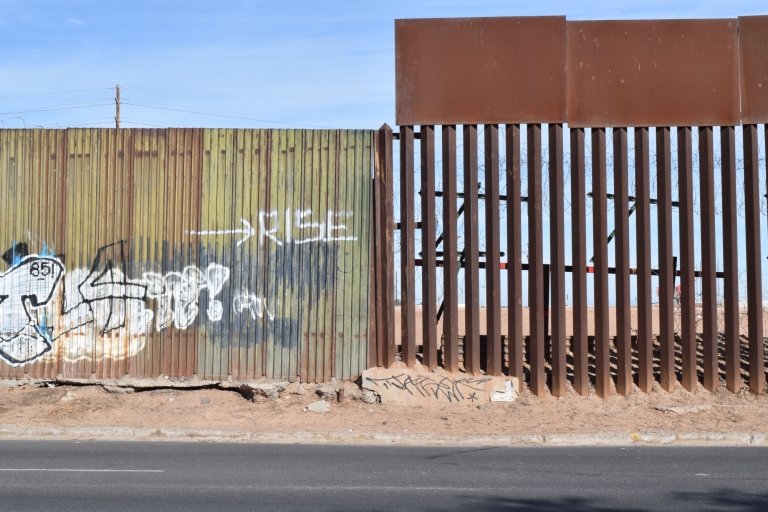
While Tijuana’s immigrant support communities band together every few years for a striking installment of white crosses, Mexicali is poorer; with transportation in the overlong summer proving to be exhausting, and large gatherings physically difficult to sustain. As a result, our crosses are ephemeral. Without the enduring power of mass visibility, they are taken down as soon as they are put up. The biggest loss took place around 2018, when efforts to remodel the border wall according to president Trump’s mandate began. With the removal of the former wall also went a small row of white crosses, most of them bearing the label “UNIDENTIFIED”. I’ve found no surviving pictures of this era.
Memorializing the unidentified is more than a symbolic act for a city that contends so much with the physicality of anonymous death. Mexicali’s unidentified corpses – the undocumented, the homeless, and those taken by cartel violence – signify a forensic emergency: in 2019, over 150 Mexicalian bodies went unidentified.
Spirituality for so many deaths must also transcend specific faiths. Jesus’ cross carries its imperial implications, and Mexico has been majority Catholic since its colonization. But these crosses share space on the border with rows of street merchandise, statuettes of Budai popularized by the founding Chinese community, clay sculptures of Santa Muerte: all faiths shunned from funerals, homes of eucharist bread and stained glass. On the border, the cross is universal, a symbol of an international struggle for the right to die well, in the face of a colony whose impositions have somewhat done away with religion, but cling to alienation and destitution.
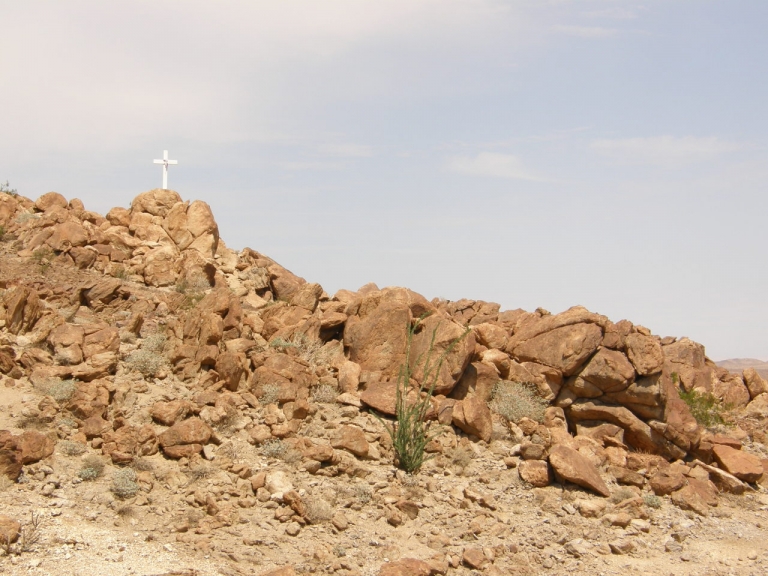
Not all anonymous crosses are in Mexicali itself. The Rumorosa, the sinuous mountain rising at the city’s west, has its own border wall, and its own toll of migrants, hoping to elude the city’s dense police presence. The Rumorosa’s highway is one of México’s most dangerous. Traversing the mountain path, it’s impossible to tell the crosses memorializing migrants apart from those memorializing road accidents. Perched on an outcropping is a temple full of graffiti and unnamed offerings to one of Mexico’s most popular saints: Judas Thaddeus, the saint of the impossible.
Placement of the anonymous cross is a political act. It calls attention to both the circumstances of the death itself, and to the necessity of fixing the forensic system of two nations at once. Just as saliently, though, it is a spiritual act. Regardless of who erects it, the anonymous cross is an act of mourning for a city permanently bereaved. When a death cannot settle in the body, it spreads across its community. Anonymous crosses are the only way in which to release the grief trapped in a border city: democratic by imposition, dedicated only to the mourned.
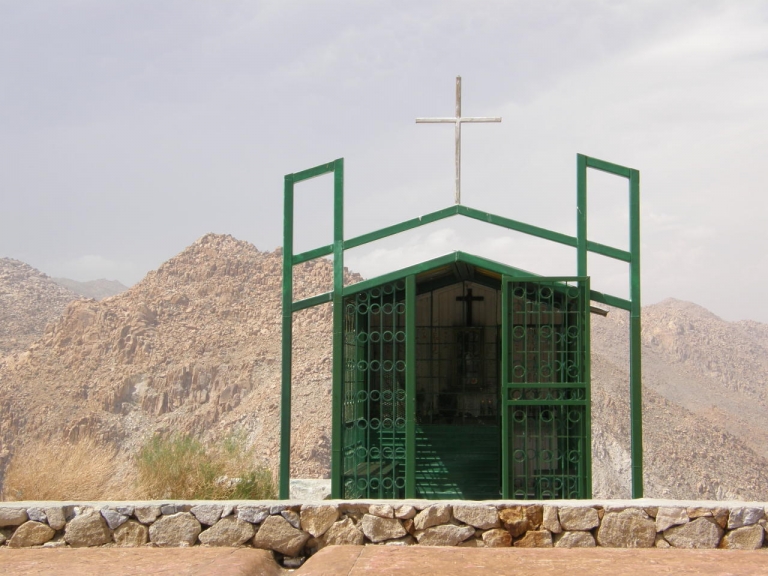
After a long four years of fearmongering accusations from the American government, the illusion of the border’s liminality has been broken. The world now knows that people are born here, arrive to stay and live here. So long as the arid machinery of immigration continues its desertification, the anonymous cross will continue to reappear. The practice of communal mourning for those who cannot be grieved by name is a denial of the dehumanization the border imposes on us. Every anonymous cross is a reminder, as much to ourselves as to the colonial system, that no death can be reduced to a statistic.
Julia Norza is interested in borders: between countries, genders and minds. First-hand witnesses have described her work being featured in The Order Of The Good Death, An Injustice! Magazine, and Deconreconstruction.
